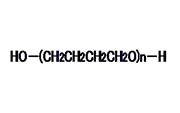Poly(tetramethylene ether)glycolPoly(tetramethylene ether)glycol
Mitsubishi Chemical Corporation
PTMG (Poly(tetramethylene ether)glycol / PTMG) is a linear polyether glycol with hydroxyl groups on both ends. As a polyol, it reacts readily with isocyanates (for example MDI, TDI), etc. to make resins with excellent properties.
- Grades:
- PTMG250、PTMG650、PTMG850、PTMG1000、PTMG1300、PTMG1500、PTMG1800、PTMG2000、PTMG3000、PTMG3200(developed grade in mass production)
- Japan, Chemical Substances Control Law:
- METI-No. 7-129
- Japan, Poisonous and Deleterious Substances Control Law:
- Not applicable.
- Japan, Fire Services Law:
- Hazardous Material Class 4 Petroleums No.3 Hazardous Rank III (PTMG250)
Hazardous Material Class 4 Petroleums No.4 Hazardous Rank III (PTMG650,850)
Combustible Materials, Flammable Solids (PTMG1000, 1300, 1500, 1800, 2000, 3000, 3200(developed grade in mass production))
Characteristics
[Close]
PTMG is a linear polyether glycol with hydroxyl groups on both ends.
| Common Names |
|
|---|---|
| Structure | HO-(CH2CH2CH2CH2O)n-H |
| Japan, Chemical Substances Control Law METI-No. | (7)-129 |
| Japan, Poisonous and Deleterious Substances Control Law | Not applicable. |
| Japan, Fire Services Law | Hazardous Material Class 4 PetroleumsNo.3 Hazardous Rank Ⅲ (PTMG250) |
| Hazardous Material Class 4 PetroleumsNo.4 Hazardous Rank Ⅲ (PTMG650,850) |
|
| Combustible Materials, Flammable Solids (PTMG1000,1300,1500,1800,2000,3000,3200(developed grade in mass production)) |
| Grade | PTMG250 |
PTMG650 | PTMG1000 | PTMG2000 | PTMG3000 | PTMG3200 (developed grade in mass production) |
|---|---|---|---|---|---|---|
| Appearance | Colorless transparent liquid | Colorless transparent liquid ~ Solid white wax Colorless transparent liquid when melted |
Solid white wax Colorless transparent liquid when melted |
Solid white wax Colorless transparent liquid when melted |
Solid white wax Colorless transparent liquid when melted |
Solid white wax Colorless transparent liquid when melted |
| Odor | Odorless | Odorless | Odorless | Odorless | Odorless | Odorless |
| Avg. Molecular Wt. | 225 | 650 | 1000 | 2000 | 2900 | 3200 |
| Freezing point(℃) | -20 | 11 | 17 | 20 | 21 | ― |
| Flash point(℃) | 181 | 237 | 247 | 240 | 246 | ― |
| Specific gravity(40/4℃) | ― | 0.982 | 0.979 | 0.976 | 0.974 | ― |
| Viscosity (mPa・s) |
50(20℃) 40(40℃) |
160(40℃) | 320(40℃) | 1400(40℃) | 3450(40℃) | 4400(40℃) |
| Specific heat (kJ/kg・K) |
― | ― | 2.0(40℃) | 2.0(40℃) | ― | ― |
Applications
[Close]
PTMG shows the following outstanding characteristics as a soft segment of polyurethane and polyester resins. The resins obtained are used over a broad range of applications, from common consumer goods such as garments, to the industrial materials such as machine parts.
Applications are expected to continue to grow.
- Impact resilience
- Hydrolysis resistances
- Low temperature flexibility
- Wear resistance
- Tear resistance
- Fungus resistance
Main Applications
Polyurethane Application
- Polyurethane elastic fibers (Spandex)
- Polyurethane elastomers
Thermoset elastomers (TSU)
Thermoplastic elastomers (TPU) - Paints and coatings
- Adhesives and sealants
- Artificial suede and synthetic leather
Polyester Applications
- Polyester elastomers (TPEE)
Polyamide Applications
- Polyether amide elastomers
Storage and Handling
[Close]
PTMG is hygroscopic and will degrade if exposed to oxygen or air, so it should be well-sealed with dry nitrogen.
PTMG is a white, waxy sold at room temperature, but will become a clear, colorless liquid upon heating. If it has solidified in the drum, it can be melted by holding the drum at about 70℃ for 24 hours. Avoid localized heating however. For storage in the liquid state, it is recommended to maintain temperature at less than 50℃.
PTMG250 is classified under the Japanese Fire Services Act as hazardous materials, Class 4, Petroleums No.3, Hazardous Rank III. PTMG650 and 850 are classified under the Japanese Fire Services Act as hazardous materials, Class 4, Petroleums No.4, Hazardous Rank III. Volatility is low, and it is unlikely to catch fire at room temperature. But if it is burning, extinguish the fire with dry chemical, alcohol-resistant foam, or large quantities of water. Although PTMG has relatively low toxicity and is relatively safe, use standard protective equipment such as goggles and gloves when handling it.
Lineup / Specifications
[Close]
| Molecular Weight | Hydroxyl value mgKOH/g |
Acid number mgKOH/g |
Moisture% | Volatiles% | Hue (Hazen) |
|
|---|---|---|---|---|---|---|
| PTMG 250 |
225±20 | 458.0~547.3 | <0.1 | <0.03 | <0.1 | <40 |
| PTMG 650 | 650±50 | 160~187 | <0.05 | <0.03 | <0.1 | <50 |
| PTMG 850 | 850±50 | 125~140 | <0.05 | <0.03 | <0.1 | <50 |
| PTMG 1000 | 1000±50 | 107~118 | <0.05 | <0.03 | <0.1 | <50 |
| PTMG 1300 | 1300±65 | 82~91 | <0.05 | <0.03 | <0.1 | <50 |
| PTMG 1500 | 1500±75 | 71~79 | <0.05 | <0.03 | <0.1 | <50 |
| PTMG 1800 | 1800±100 | 59~66 | <0.05 | <0.03 | <0.1 | <50 |
| PTMG 2000 | 2000±100 | 53~59 | <0.05 | <0.03 | <0.1 | <50 |
| PTMG 3000 | 3000±200 | 35~40 | <0.05 | <0.03 | <0.1 | <50 |
| PTMG 3200 (developed grade in mass production) |
3150±200 | 33.5~38.0 | <0.05 | <0.03 | <0.1 | <50 |
Specifications for the developed grade in mass production is subject to change over time.
| Tanker Truckload (Lorry) | 10ton / 13ton |
|---|---|
| Drum | 180kg,200kg(depending on grade) |
| Oilcan | 15kg |
Inquiries Concerning Products
View the products of C4 & PBT Dept., Mitsubishi Chemical[Open in a new window]
